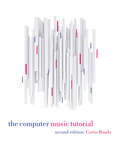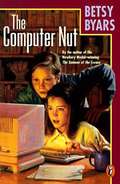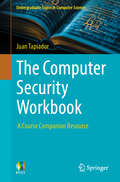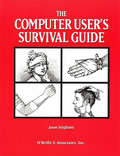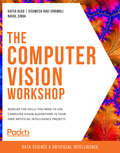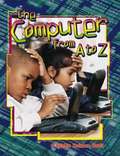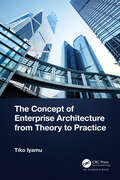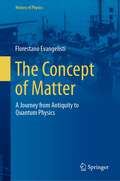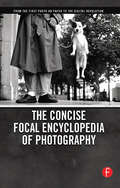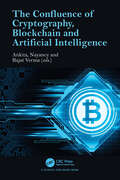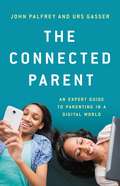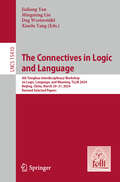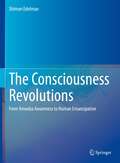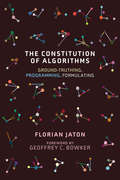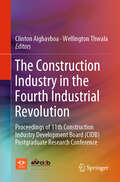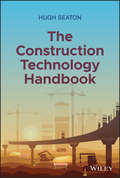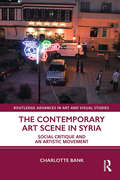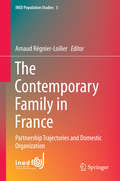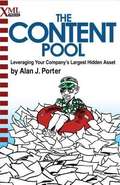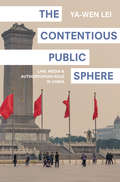- Table View
- List View
The Computer Music Tutorial, second edition
by Curtis RoadsExpanded, updated, and fully revised—the definitive introduction to electronic music is ready for new generations of students.Essential and state-of-the-art, The Computer Music Tutorial, second edition is a singular text that introduces computer and electronic music, explains its motivations, and puts topics into context. Curtis Roads&’s step-by-step presentation orients musicians, engineers, scientists, and anyone else new to computer and electronic music.The new edition continues to be the definitive tutorial on all aspects of computer music, including digital audio, signal processing, musical input devices, performance software, editing systems, algorithmic composition, MIDI, and psychoacoustics, but the second edition also reflects the enormous growth of the field since the book&’s original publication in 1996. New chapters cover up-to-date topics like virtual analog, pulsar synthesis, concatenative synthesis, spectrum analysis by atomic decomposition, Open Sound Control, spectrum editors, and instrument and patch editors. Exhaustively referenced and cross-referenced, the second edition adds hundreds of new figures and references to the original charts, diagrams, screen images, and photographs in order to explain basic concepts and terms.FeaturesNew chapters: virtual analog, pulsar synthesis, concatenative synthesis, spectrum analysis by atomic decomposition, Open Sound Control, spectrum editors, instrument and patch editors, and an appendix on machine learningTwo thousand references support the book&’s descriptions and point readers to further studyMathematical notation and program code examples used only when necessaryTwenty-five years of classroom, seminar, and workshop use inform the pace and level of the material
The Computer Nut
by Betsy ByarsTen-year-old Kate begins a communication exchange on a computer with someone purporting to be from outer space, who says he is going to pay a visit to Earth soon.
The Computer Security Workbook: A Course Companion Resource (Undergraduate Topics in Computer Science)
by Juan TapiadorMastering computer security requires more than just technical knowledge of software, systems and networks—it demands analytical thinking, a problem-solving mindset, and creative reasoning. These skills are best cultivated through practical challenges and structured problem-solving. This book presents a collection of questions and problems on a wide range of topics typically taught in introductory computer security courses, including basic concepts and principles, authentication techniques, access control models and methods, network security, software vulnerabilities, and malware. Topics and features: The exercises range in complexity to ensure progressive skill development—from foundational knowledge (e.g., defining and understanding basic security ideas and principles) to more advanced problem-solving (e.g., applying knowledge to analyze a security protocol, synthesizing concepts, making judgments about a design, or creating solutions). Each exercise is accompanied by a solution intended to serve as a learning aid and facilitate self-assessment. Some solutions include historical notes and additional references that could be useful to readers who are willing to explore a subject in more depth. The problems include practical scenarios and real-world cases, ensuring that readers understand how principles are applied in practice. The content is organized into sections and chapters that are mostly self-contained, so readers can explore them in any order. The material is flexible and can be adapted for various courses and audiences, allowing instructors and learners to select topics based on their needs. This unique textbook/reference offers broad appeal: The exercises are intended to complement other learning materials and are tailored to different skill levels, allowing beginners to build a strong foundation while offering advanced challenges to more experienced learners.
The Computer Teacher From The Black Lagoon
by Mike Thaler Jared LeeA boy contemplates all the horrible stories he has heard about the computer teacher, Miss Pluggins, and the ordeals she forces her students to endure.
The Computer User's Survival Guide: Staying Healthy in a High Tech World
by Joan StiglianiYou probably suspect, on some level, that computers might be hazardous to your health. You might vaguely remember a study that you read years ago about miscarriages being more frequent for data entry operators. Or you might have run into a co-worker wearing splints and talking ominously about Workers' Comp insurance. Or you might notice that when you use a computer too long, you get stiff and your eyes get dry.But who wants to worry about such things? Surely, the people wearing splints must be malingerers who don't want to work? Surely, the people who design keyboards and terminals must be working to change their products if they are unsafe? Surely, so long as you're a good worker and keep your mind on your job, nothing bad will happen to you?The bad news is: You can be hurt by working at a computer. The good news is that many of the same factors that pose a risk to you are within your own control. You can take action on your own to promote your own health -- whether or not your terminal manufacturer, keyboard designer, medical provider, safety trainer, and boss are working diligently to protect you.The Computer User's Survival Guide looks squarely at all the factors that affect your health on the job, including positioning, equipment, work habits, lighting, stress, radiation, and general health.Through this guide you will learn:a continuum of neutral postures that you can at utilize at different work taskshow radiation drops off with distance and what electrical equipment is responsible for most exposurehow modern office lighting is better suited to working on paper than on a screen, and what you can do to prevent glaresimple breathing techniques and stretches to keep your body well oxygenated and relaxed, even when you sit all dayhow reading from a screen puts unique strains on your eyes and what kind of vision breaks will keep you most productive and restedwhat's going on "under the skin" when your hands and arms spend much of the day mousing and typing, and how you can apply that knowledge to prevent overuse injuriesThe Computer User's Survival Guide is not a book of gloom and doom. It is a guide to protecting yourself against health risks from your computer, while boosting your effectiveness and your enjoyment of work.
The Computer Vision Workshop: Develop The Skills You Need To Use Computer Vision Algorithms In Your Own Artificial Intelligence Projects
by Hafsa Asad Milon BhattacharyaIf you are a researcher, developer, or data scientist looking to automate everyday tasks using computer vision, this workshop is for you. Although not necessary, aA basic understanding of Python and deep learning will help you to get the most out of this workshop.
The Computer from A to Z
by Bobbie KalmanComputer language and "byte-sized" facts are introduced and explained in this easy-to-read book that children will enjoy. Full-color photos of children working with computers highlight such subjects as e-mail, hardware, the internet, and virtual reality.
The Computing Universe
by Tony Hey Gyuri PápayComputers now impact almost every aspect of our lives, from our social interactions to the safety and performance of our cars. How did this happen in such a short time? And this is just the beginning. . . . In this book, Tony Hey and Gyuri Pápay lead us on a journey from the early days of computers in the 1930s to the cutting-edge research of the present day that will shape computing in the coming decades. Along the way, they explain the ideas behind hardware, software, algorithms, Moore's Law, the birth of the personal computer, the Internet and the Web, the Turing Test, Jeopardy's Watson, World of Warcraft, spyware, Google, Facebook, and quantum computing. This book also introduces the fascinating cast of dreamers and inventors who brought these great technological developments into every corner of the modern world. This exciting and accessible introduction will open up the universe of computing to anyone who has ever wondered where his or her smartphone came from.
The Concept of Enterprise Architecture from Theory to Practice
by Tiko IyamuEven though the field of enterprise architecture (EA) has matured, many organisations still struggle with its development and implementation, particularly those organisations involved in continuous transformational cycles and subjected to different environmental trends. This book is intended to assist organisations in getting a grip on the factors influencing EA implementation and gaining a deeper understanding of why things happen the way they do in the practice of EA. It is a comprehensive and definitive resource that is useful to both business professionals and academics. The book presents an approach for the development, implementation, or institutionalisation of EA that is independent of any method or other architecture frameworks. It can be applied directly using a realistic selection of organizational variables. The approach has two distinctive features that support EA, even in complex environments: From both technical and non-technical perspectives, it identifies influencing factors and how they manifest in the practice of EA in an organization. It offers linear and practical mechanisms for developing and implementing EA to fortify the practice of the concept in an organisation. This approach represents a significant contribution to EA. Starting with descriptions for EA, the book offers deepened models and frameworks for the development and implementation of EA at the domain level. It also covers factors upon which a model is built for the institutionalisation of the concept. Additionally, the book discusses the implications of EA for sponsors, architects, and other stakeholders responsible for EA development, implementation, and institutionalisation.
The Concept of Matter: A Journey from Antiquity to Quantum Physics (History of Physics)
by Florestano EvangelistiOur current concept of matter, one of scientific research’s greatest successes, represents a long journey, from questions posed during the birth of philosophy in Ancient Greece to recent advances in physics and chemistry, including Quantum Physics. This book outlines that journey. The book has three parts, each detailing a phase of the journey. The first saw the development of a conception based on "classical" physics; the second saw the construction of the "old" quantum theory attempting to explain the mysterious properties of matter, resulting in formulation of the "new" quantum theory; the third saw the formation of the modern conception of matter, based on quantum mechanics. Along the way, various topics are discussed, including: rediscovery and appropriation of antiquity by Western culture in the modern era; the subsequent revision process in the 16th and 17th centuries and the new experiments and theories of the 18th; attempts to understand the mysterious properties of matter that could not be explained by classical physics; the first quantization hypotheses; discovery of new purely "quantum-mechanical" properties of matter; and the ultimate clarification of atomic structure. This book is aimed at anyone who wants a clear picture of how we arrived at the modern conception of matter.
The Concise Focal Encyclopedia of Photography: From the First Photo on Paper to the Digital Revolution
by Michael R. Peres Mark Osterman Grant B. R Omer Nancy M. Stuart J. Tomas LopezDefining photography is impossible. Revealing it is another matter, and that's what The Concise Focal Encyclopedia of Photography does,with each turn of the page.History: The technical origins and evolution of photography are half of the story. The other half consists of the ways that cultural forces have transformed photography into a constellation of practices more diverse than any other mode of representation. Photographers can tell a more in-depth story through a photo like Dorothea Lange's "Migrant Mother" than a journalist ever could with the written word alone.Major themes and practitioners: Over 25 entries, many with supporting illustrations,examine the figures, trends, and ideas that have contributed most heavily to the history and current state of photography.Contemporary issues: The issues influencing photography today are more complex than at any other time in its history. Questions of ethics, desire, perception, digitization, and commercialization all vie for attention. Hear what the experts have to say about crucialissues such as whether or not the images we take today will last the test of time, and if so, how?When material is covered this skillfully, "concise" is no compromise. The Concise Focal Encyclopedia of Photography is packed with useful information, compellingideas, and - best of all - pure pleasure.
The Concise PRINCE2®
by Colin BentleyThe only PRINCE2(R) checklist you'll ever need! Written by a former Chief Examiner for PRINCE2(R), this pocket guide contains all you need to prompt your memory at the crucial time. It is laid out in a clear and comprehensible format with helpful diagrams and tables, and will enable you to: bring to mind the information you need, just when you need it keep the key principles at the forefront of your mind focus on what you are trying to achieve follow the correct processes, in the right order tailor the system to suit your needs and objectives manage a successful project from beginning to end add value to your business.
The Confluence of Cryptography, Blockchain and Artificial Intelligence
by Rajat Verma Nayancy AnkitaWith blockchain underpinning cryptocurrencies and improving IoT security, this book uncovers the evolution of blockchain (1.0 to 4.0) and its applications. It also introduces AI, discussing its development, paradigms, and industry-wide impact. The book explores the integration of cryptography, blockchain, and artificial intelligence (AI) in areas such as big data, bioinformatics, IoT, 5G, and Industry 4.0. It highlights how these technologies drive the digital revolution, enabling multi-agent systems, autonomous models, and enhanced security.
The Connected Home: The Future of Domestic Life
by Richard HarperThe title of this new book: "The Connected Home" reflects the move away from the idea that smart homes would alter the lives of those living in them by providing technologies to take over tasks that were previously the responsibility of the householder, such as managing entertainment, education - and even eating! Up until around 10 years ago this view was commonplace but time has shown that the technologies to support a smart home have not developed in such a way as to support this premise. Instead, what people do in their homes has moved the concept of a smart home into that of the 'connected home'. The rise of on-line games technologies, video connections via Skype, social networking, internet browsing etc are now an integral part of the home environment and have had a significant effect on the home. The contributors to this exciting new book consider and discuss the effects and ramifications of the connected home from a variety of viewpoints: an examination of the take-up of personal computers and the Internet in domestic situations; an analysis of the changing intersection of technology and human habits in the connected home; the impact of gaming, texting, e-book readers, tablets and other devices and their effect on the social conditions of a household; the relationship between digital messaging applications and real geography; and an overview of how sensing technologies for the smart home might evolve (lightweight medical technologies for example). The book culminates by addressing unfinished ambitions from the smart home agenda, the factors that have prevented their realisation, and addresses the need for extending research into the area.
The Connected Parent: An Expert Guide to Parenting in a Digital World
by John Palfrey Urs GasserAn essential guide for parents navigating the new frontier of hyper-connected kids.Today's teenagers spend about nine hours per day online. Parents of this ultra-connected generation struggle with decisions completely new to parenting: Should an eight-year-old be allowed to go on social media? How can parents help their children gain the most from the best aspects of the digital age? How can we keep kids safe from digital harm? John Palfrey and Urs Gasser bring together over a decade of research at Harvard to tackle parents' most urgent concerns. The Connected Parent is required reading for anyone trying to help their kids flourish in the fast-changing, uncharted territory of the digital age.
The Connectives in Logic and Language: 4th Tsinghua Interdisciplinary Workshop on Logic, Language, and Meaning, TLLM 2024, Beijing, China, March 29–31, 2024, Revised Selected Papers (Lecture Notes in Computer Science #15410)
by Mingming Liu Dag Westerståhl Jialiang Yan Xiaolu YangEdited in collaboration with FoLLI, the Association of Logic, Language and Information, this book constitutes the refereed proceedings of the 4th Tsinghua Interdisciplinary Workshop on Logic, Language, and Meaning, TLLM 2024, held in Beijing, China during in March 29-31, 2024.The 8 full papers were carefully reviewed and selected from 49 submissions. This workshop also focused on the apparently simpler connectives expressing (various versions of) conjunction, disjunction, and negation.
The Consciousness Revolutions: From Amoeba Awareness to Human Emancipation
by Shimon EdelmanThis book is about all things consciousness, great and small. It starts by pointing to the key characteristic of consciousness, without realizing which it cannot be understood: like everything else about the mind, it is fundamentally a kind of computation. Among many other matters, this explains: how it is that we share some aspects of consciousness with bacteria; how it can arise in artificial machines and not just living ones; how the empty cocoon of the self that it spins ends up pretending to be the butterfly; and how consciousness dooms this virtual butterfly to the splendor and the suffering of being awake and aware. Unlike most other books on consciousness, this one includes a discussion of some possible ways whereby we, pinned like butterflies by our species’ history and socioeconomic circumstances, can awake to our collective predicament and join forces to do something about it. It should be of interest to all readers who care about the nature of our lived experience — and about our survival, which depends on developing critical consciousness of our dire situation and the social dynamics that shape it.
The Constitution of Algorithms: Ground-Truthing, Programming, Formulating (Inside Technology)
by Florian JatonA laboratory study that investigates how algorithms come into existence.Algorithms--often associated with the terms big data, machine learning, or artificial intelligence--underlie the technologies we use every day, and disputes over the consequences, actual or potential, of new algorithms arise regularly. In this book, Florian Jaton offers a new way to study computerized methods, providing an account of where algorithms come from and how they are constituted, investigating the practical activities by which algorithms are progressively assembled rather than what they may suggest or require once they are assembled.
The Construction Industry in the Fourth Industrial Revolution: Proceedings of 11th Construction Industry Development Board (CIDB) Postgraduate Research Conference
by Clinton Aigbavboa Wellington ThwalaThis book gathers papers from the 11th Construction Industry Development Board (cidb) Postgraduate Research Conference, held on 28–30 July 2019 in Johannesburg, South Africa. The conference provided an essential forum for reviewing and generating knowledge on Construction 4.0 and, consequently, highlighted processes and practices that allow us to deliver and operate built environment assets more effectively and efficiently by focusing on physical-to-digital and digital-to-physical transformation. The event addressed three broad themes: Industrial production (prefabrication, 3-D printing and assembly, offsite and advanced manufacturing);Cyber-physical systems (actuators, sensors, IoT, robots and cobots for repetitive and dangerous tasks, and drones for mapping, progress monitoring, safety and quality inspections, lifting, moving and positioning); and Technologies (digital ecosystems, digital platforms, BIM, video and laser scanning, AI and cloud computing, big data and data analytics, reality capture, blockchain, simulation, virtual and augmented reality, data standards and interoperability, and vertical and horizontal integration). Given its scope, the book will be of interest to all construction industry and architectural professionals who want to learn about cutting-edge technologies applied to construction
The Construction Technology Handbook
by Hugh SeatonTired of new software that doesn’t seem to work in the field? Ready to get your teams up to speed and productive with the latest tools? The Construction Technology Handbook takes a ground up, no jargon look at technology in the construction industry. From clear, quickly grasped explanations of how popular software actually works to how companies both large and small can efficiently try out and onboard new tools, this book unlocks new ways for construction field teams, firm owners, managers, leaders, and employees to do business. You’ll learn about: Simple frameworks for making sense of all the new options cropping up How software and data work and how they work together to make your job easier and safer What artificial intelligence really is and how it can help real companies today Tools that are just over the horizon that will, one day, make your job just a little bit easier New and practical resources to help you incorporate an attitude of innovation and technology adoption into your workplace Perfect for general contractors and subcontractors, The Construction Technology Handbook also belongs on the bookshelves of construction technology vendors and construction workers who want to better understand the needs of the construction industry and the inner workings of construction technology, respectively.
The Contemporary Art Scene in Syria: Social Critique and an Artistic Movement (Routledge Advances in Art and Visual Studies)
by Charlotte BankThis book focuses on the expanding contemporary art scene in Syria, particularly Damascus, during the first decade of the twenty-first century. The decade was characterized by a high degree of experimentation as young artists began to work with artistic media that were new in Syria, such as video, installation and performance art. They were rethinking the role of artists in society and looking for ways to reach audiences in a more direct manner and address socio-cultural and socio-political issues. The Contemporary Art Scene in Syria will be of interest to scholars of global and Middle Eastern art studies, and also to scholars interested in the recent social and cultural history of Syria and the wider Middle East.
The Contemporary Family in France
by Arnaud Régnier-LoilierThis book provides a portrait of the family in France today, revealing many of the deep-seated, demographic changes that have affected French society in recent decades. It first focuses on conjugal and family trajectories, examining union formation, types of union, entry into parenthood, influence of religion, and separation. Next, the book explores domestic organization within the couple. It looks at gender differences in attitudes to task-sharing, division of household and parenting tasks, influence of past partnership history, and changes after a birth. The book presents a series of studies based on the French version of the international Generations and Gender Survey, a major comparative research project conducted in 20 countries to collect information from individuals aged 18-79 about relationships and processes in the life course. Inside, readers will find insightful analysis of the survey results by sociologists, demographers, and economists, and come to better understand recent demographic and social developments in France as well as the factors influencing them. The book will appeal to a broad audience of students and researchers interested in family, gender, and intergenerational relations. In addition, as the survey data are comparable across countries, the book will provide researchers with ideas for further research opportunities in Europe and beyond.
The Content Pool
by Alan J. PorterAll companies, no matter what industry they are in, or what product or service they create, do four basic things. Offer something for sale, sell it, collect money for it, and create content about what they do. Product development, Marketing, Sales, and Finance are all essential to the organization and are typically managed at the VP or CXO level, yet a company's content, which contains all of its intellectual property, is often overlooked. The Content Pool: Leveraging Your Company's Largest Hidden Asset makes the case for placing content creation, management, and distribution on a par with other core strategic business activities. Inside the Book Identifying Your Content Organizing Your Content Managing Your Content Leveraging Your Content The Case for a Chief Content Officer Bibliography and Index
The Contentious Public Sphere: Law, Media, and Authoritarian Rule in China
by Ya-Wen LeiSince the mid-2000s, public opinion and debate in China have become increasingly common and consequential, despite the ongoing censorship of speech and regulation of civil society. How did this happen? In The Contentious Public Sphere, Ya-Wen Lei shows how the Chinese state drew on law, the media, and the Internet to further an authoritarian project of modernization, but in so doing, inadvertently created a nationwide public sphere in China—one the state must now endeavor to control. Lei examines the influence this unruly sphere has had on Chinese politics and the ways that the state has responded.Using interviews, newspaper articles, online texts, official documents, and national surveys, Lei shows that the development of the public sphere in China has provided an unprecedented forum for citizens to influence the public agenda, demand accountability from the government, and organize around the concepts of law and rights. She demonstrates how citizens came to understand themselves as legal subjects, how legal and media professionals began to collaborate in unexpected ways, and how existing conditions of political and economic fragmentation created unintended opportunities for political critique, particularly with the rise of the Internet. The emergence of this public sphere—and its uncertain future—is a pressing issue with important implications for the political prospects of the Chinese people.Investigating how individuals learn to use public discourse to influence politics, The Contentious Public Sphere offers new possibilities for thinking about the transformation of state-society relations.
The Contest over National Security: FDR, Conservatives, and the Struggle to Claim the Most Powerful Phrase in American Politics
by Peter RoadyA new history shows how FDR developed a vision of national security focused not just on protecting Americans against physical attack but also on ensuring their economic well-being—and how the nascent conservative movement won the battle to narrow its meaning, durably reshaping US politics.Americans take for granted that national security comprises physical defense against attacks. But the concept of national security once meant something more. Franklin Roosevelt’s vision for national security, Peter Roady argues, promised an alternate path for the United States by devoting as much attention to economic want as to foreign threats. The Contest over National Security shows how a burgeoning conservative movement and power-hungry foreign policy establishment together defeated FDR’s plans for a comprehensive national security state and inaugurated the narrower approach to national security that has dominated ever since.In the 1930s, Roosevelt and his advisors, hoping to save the United States from fascism and communism, argued that national security entailed protection from both physical attack and economic want. Roosevelt’s opponents responded by promoting a more limited national security state privileging military defense over domestic economic policy. Conservatives brought numerous concerns to bear through an enormous public relations offensive, asserting not just that Roosevelt’s plans threatened individual freedom but also that the government was less competent than the private sector and incapable of delivering economic security.This contest to define the government’s national security responsibilities in law and in the public mind, Roady reveals, explains why the United States developed separate and imbalanced national security and welfare states, with far-reaching consequences. By recovering FDR’s forgotten vision, Roady restores a more expansive understanding of national security’s meanings as Americans today face the great challenges of their times.
